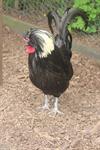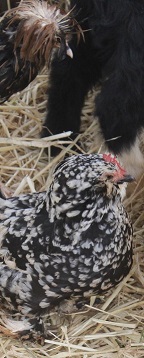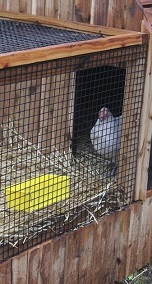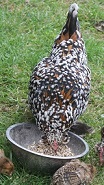An Introduction to the Care and Management of Poultry
 Developed and tutored by a team of experts with both qualifications in animal husbandry and experience with poultry.
Developed and tutored by a team of experts with both qualifications in animal husbandry and experience with poultry.- The course covers Terminology, Breeds , Nutrition, Diseases In Poultry, Layers, Broilers, Incubation, Brooding, Management and more.
A sound foundation course for: home chicken raising and farm workers.
Lesson Structure
There are 8 lessons in this course:
- Introduction, Terminology and Breeds
- History of Poultry
- Terminology
- Contract Growing
- Regulations
- Management Factors
- Small Scale Production
- Breeds
- Classifying Fowls (Egg Laying Breeds, Meat or Table Birds, Dual Purpose Breeds)
- Cross Breed Poultry
- Sex Linkage
- Brooders
- Skeletal System
- Poultry Husbandry (Stock Selection, Feeding, Watering, Housing, Health)
- Turkeys
- Geese
- Ducks
- Poultry Nutrition

- Digestive System (Gullet, Crop, Proventriculus, Gizzard, Intestine, Caecum, etc)
- Nutrient Sources (Carbohydrate, Protein, Minerals etc)
- Rationing
- Palatability
- The End Product
- Modern Feed Requirements
- Phase Feeding
- Limited Feeding
- Consumption Feeding
- Diseases
- Avoiding Stress
- Viral diseases
- Bacterial diseases
- Mycoplasmosis, fungal and protozoan disease
- Non-infectious diseases
- Layers
- Extensive (free-range) System
- Semi-Intensive System
- Intensive Systems
- Housing
- Deep Litter System
- Feeders
- Battery Units
- Feeding the Laying Hen
- Replacing the Flock
- Broilers
- Caponising
- Brooding Period
- Feeding Broilers (Starter Period, Finisher Period)
- Housing
- Hygiene and Health
- Incubation - The natural method (using broody hens)
- The artificial method (using incubators)
- Selecting Eggs
- Storing Hatching Eggs
- Turning Eggs
- Managing a Incubator (Temperature, Humidity, Testing, Hatching)
- Reasons for Poor Hatchability
- Brooding
- Heating
- The canopy brooder
- The infra-red lamp
- The battery brooder
- The hay box brooder
- Feeders
- Drinkers
- Floor Space
- Rearing
- Problems during rearing
- Record Keeping, economics and Marketing
- Growth Records
- Egg Production records
- Small Scale Business
- Compatible Ventures (Manure, etc)
- Preparing a Farm Business plan
- Finance
- Land Management
- Analyzing the Market place
- Developing a Marketing Plan
Each lesson culminates in an assignment which is submitted to the school, marked by the school's tutors and returned to you with comments, guidance, and if necessary, extra reading.
Aims

- Select appropriate poultry breeds for use in different production situations.
- Explain the techniques used in the management of condition, including both feeding, and pest and disease control, of poultry.
- Explain the management of poultry as layers.
- Explain the procedures for the management of poultry as broilers.
- Explain the techniques used in the management of poultry incubation.
- Explain the management of brooding poultry.
- Develop management strategies for a poultry business.
What You Will Do
- Distinguish between cross bred and pure bred poultry, being grown in your locality.
- Categorise different breeds of poultry, including ducks, geese, chickens and turkeys; into groups, including:
- Egg laying birds
- Meat/Table birds
- Dual purpose breeds.
- Explain the advantages of cross breeding poultry for two different specified purposes.
- Label the parts of a chicken on a supplied unlabelled illustration.
- Evaluate ten different poultry breeds to determine the most suitable breeds for three different specified purposes.
- Label on an unlabelled illustration, the parts of the digestive tract of a fowl.
- Describe the function of different parts of the digestive system of poultry.
- List the dietary sources of different nutrients for poultry.
- Describe the function of five different ingredients in specified poultry feeds.
- Explain how rations of feed are determined for poultry.
- Describe the feeding of poultry stock in a specified situation.
- Describe possible dietary disorders in poultry.
- Describe commercially significant pests and diseases in poultry.
- Develop a checklist to be used for regular inspections to detect signs of ill health in poultry.
- Explain the treatment of six different pests and diseases in poultry.
- Describe a poultry vaccination program for a specified property.
- Explain the techniques for, and the value of, quarantine procedures for poultry.
- Compare extensive (free range), semi-intensive and intensive production systems, in terms of:
- management
- production cost
- product quality.
- Describe different housing requirements for poultry.
- Explain a commercially viable method of collecting eggs, used on a specific poultry farm.
- Explain three procedures used in an egg production system which are critical to the efficient operation of a specified farm.
- Develop a production plan for laying poultry, which includes details of;
- birds required
- facilities required
- materials needed
- a schedule of husbandry tasks
- cost estimates.
- Describe the brooding period for a typical fowl, on a specified property.
- Explain how brooders are successfully fed, on a specific property you visit.
- Explain appropriate housing for broilers being provided at a poultry farm, as observed by you.
- Explain how hygiene and health are managed in a broiler production system, as observed by you.
- Evaluate the successful management of broilers in a specified situation.
- Describe daily routine tasks carried out in farming of broilers at a poultry farm visited by you.
- Describe the process of incubation, as observed by you on a poultry farm.
- Compare natural with artificial incubation methods, to determine appropriate applications for each type.
- List criteria for selecting eggs for incubation in a specified situation.
- List five different reasons for poor hatchability.
- Compare two different incubator designs with respect to cost and application.
- Describe the management of a specific incubator which the learner has inspected.
- Describe the characteristics which distinguish brooding poultry from other poultry.
- Explain how to create an appropriate brooding environment for a specific situation.
- Compare different types of brooders.
- Describe the operation of different brooding equipment.
- Prepare a timetable of husbandry tasks from hatching to maturity for a brooding fowl.
- Explain problems that may occur during rearing, including:
- Develop a checklist for monitoring the condition of a brooding fowl.
- List records which should be kept by a poultry farmer.
- Analyse purchasing procedures for routine supplies, used by a specified poultry farm.
- Explain the value of different records kept by a poultry farmer, including:
- growth records
- egg production records.
- List the minimum machinery required for a specified poultry enterprise.
- Calculate the cost of production, showing a breakdown of the costs, of one marketable produce item in a small poultry business.
- List factors which may be critical to successful marketing for a poultry farm.
- Explain any legal requirements which apply to a specified poultry enterprise.
- List poultry products being marketed in your locality.
- Write a job specification for one member of staff on a poultry property.
- Prepare a report on innovations in the poultry industry being used in your locality.
- Develop a detailed poultry production plan.
- Describe a successful marketing strategy employed by one supplier of poultry products in your locality.
- Recommend an innovative approach to marketing for a poultry enterprise which you are familiar with.
- Match credit to business needs of a poultry farm to develop the most suitable strategy for the enterprise
What Can You Expect From Poultry?
The modern layer bird now lays over three hundred eggs per year instead of one clutch of twelve eggs, whilst the modern broiler reaches a marketable weight of around 2.0kg live weight at around six to seven weeks. The desire to sit on eggs and hatch them has been bred out of the modern birds so that they seldom go broody. Young birds reach sexual maturity and begin to lay eggs at sixteen to twenty weeks of age unlike the wild jungle fowl who was only ready to lay at one year old.
Although the laying powers of chickens has been developed to a remarkable degree, birds stop laying once a year when they go into a moult (replace their feathers). Once they are over a moult, the birds will begin to lay eggs again but production during this second laying season will be about 20% below the production of the first season. However, the eggs from the second layer season will be larger.
Healthy hens can continue to lay eggs for many seasons, but the normal practice with commercial poultry is to keep the birds for one season's lay and then replace the birds with a new batch of pullets. Because modern layers have been bred specifically for their egg producing qualities, their carcase is of little commercial value, and is often used for soup or pet food.
Depending on the size of the poultry unit and the available housing, a supply of eggs can be maintained throughout the year by replacing the various flocks at different times of the year. Under natural conditions, egg production is highest in spring and summer which is the period of lengthening daylight.
However, all modern laying facilities provide the birds with a constant period of day light using artificial lighting. This ensures optimum production throughout the life of the bird. Birds that are kept on free range will follow the natural pattern of the seasons unless some form of artificial lighting is provided.
Poultry are economic converters of home grown food into both eggs and meat. Poultry manure is also a very valuable source of plant nutrients.
What about a Poultry Business?
 Small scale operations may sell eggs or birds (perhaps at at Farmers Markets or directly off the farm); while many larger poultry businesses today tend to become involved in contract production.
Small scale operations may sell eggs or birds (perhaps at at Farmers Markets or directly off the farm); while many larger poultry businesses today tend to become involved in contract production.
Contract growing in the poultry meat and egg industry is an established world-wide trend. In contract growing a company and a farmer sign a contract to produce broilers, breeders or replacement pullets, commercial laying hens or eggs. The contract growing method has been an established way of conducting business in the poultry industry for the last fifty years and farmers see it as means of ensuring financial security. In Australia (as an example) company or contract growers produce about 95% of the total meat bird production, the remaining 5% comes from independent growers. The success of contract growing is dependent on both parties fulfilling their obligations in relation to maximising flock performance.
In some cases the company will supply:
- Specifically formulated feed (to ensure maximum growth/egg production)
- Genetically selected chicks (for health and vigour, the ability to efficiently turn feed into growth and/or optimum egg production)
- Professional support (in relation to helping the grower achieve maximum flock performance)
- Management programs that the grower must follow
At the other end of the contract the farmer (producer) supplies and maintains:
- Good quality housing (including appropriate temperature control)
- Good quality equipment
- Expert management (daily management of flock (feed and water removal of dead stock, vaccinations) and precise record keeping i.e. mortality, feeding regimes, vaccinations etc)
- Flexibility
- As marketing needs change the grower needs to have the ability to change with it. This may include changing production systems i.e. the market demand may at some stage demand smaller or larger birds.
- Strong communication ties with the contract company (this ensures that both parties are meeting their obligations and that growers have the earliest possible knowledge of market trends.
WHAT NEXT?
Register to Study - Go to the "It's Easy to Enrol" box at the top of the page and you can enrol now.
Get Advice - use our FREE COURSE COUNSELLING SERVICE to contact our specialist tutors today.